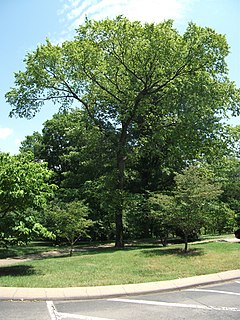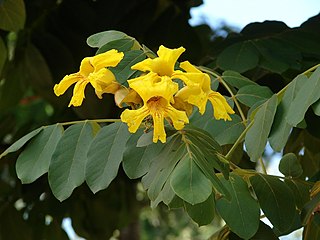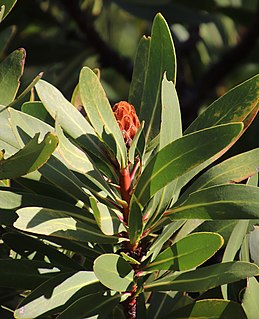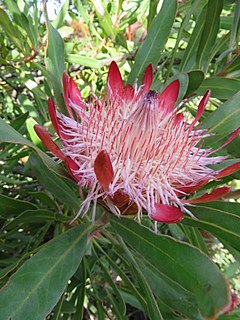
Dipteryx is a genus containing a number of species of large trees and possibly shrubs. It belongs to the "papilionoid" subfamily – Faboideae – of the family Fabaceae. This genus is native to South and Central America and the Caribbean. Formerly, the related genus Taralea was included in Dipteryx.

Ulmus crassifoliaNutt., the Texas cedar elm or simply cedar elm, is a deciduous tree native to south central North America, mainly in southern and eastern Texas, southern Oklahoma, Arkansas and Louisiana, with small populations in western Mississippi, southwest Tennessee and north central Florida; it also occurs in northeastern Mexico. It is the most common elm tree in Texas. The tree typically grows well in flat valley bottom areas referred to as 'Cedar Elm Flats'. The common name 'cedar elm' is derived from the trees' association with juniper trees, locally known as cedars.

Ulmus castaneifoliaHemsley, the chestnut-leafed elm or multinerved elm, is a small deciduous tree found across much of China in broadleaved forests at elevations of 500–1,600 metres (1,600–5,200 ft).

Ulmus szechuanicaFang, known as the Szechuan (Sichuan), or red-fruited, elm, is a small to medium deciduous Chinese tree found along the Yangtze river through the provinces of Sichuan, Jiangxi, Anhui, and Jiangsu.

Ulmus serotinaSarg., the September elm, is an autumn-flowering North American species of tree. It is uncommon beyond Tennessee; only very locally distributed through Illinois, Kentucky, Arkansas, Mississippi, Oklahoma, Alabama and Georgia, and disjunct into Nuevo León, Mexico. It grows predominantly on limestone bluffs and along streams to elevations of 400 m.

Protea neriifolia, also known as the narrow-leaf sugarbush, oleander-leaved sugarbush, blue sugarbush, or the oleanderleaf protea, is a flowering plant in the genus Protea, which is endemic to South Africa.

Protea laurifolia, also known as the grey-leaf sugarbush, is a shrub from South Africa. It is native to the Cape Provinces of South Africa.

Dipteryx charapilla is a little-known species of flowering plant in the family Fabaceae, a large to mid-sized tree growing along rivers in the rainforests of Brazil and Peru.

Protea comptonii, also known as saddleback sugarbush, is a smallish tree of the genus Protea in the family Proteaceae. It is found in South Africa and Eswatini.

Protea aristata is a compact shrub with beautiful flowers which is endemic to the southwestern part of the Cape Region of South Africa. P. aristata has become one of South Africa's most famous proteas in spite of its relatively late discovery, and re-discovery in 1953. The leaves are soft, dense and needle-like and the flower heads are a stunning crimson red, it may thus be a good potential ornamental plant for South African gardens. It is usually called the Ladismith sugarbush in South African English, although it has been called pine sugar bush in Australia. In the Afrikaans language it has the vernacular name of klein-den-suikerbos.

Markhamia lutea, the Nile tulip, Nile trumpet or siala tree is a tree species of the family Bignoniaceae, native to eastern Africa and cultivated for its large bright yellow flowers. It is related to the African tulip tree. Native to Africa, Markhamia was named in the honour of Clements Markham (1830-1916), who worked in India. An evergreen small tree that grows to 4–5 m in height outside of native zones, although it can reach more than 10 m in its zones of origin. Leaves, of 20–30 cm in length, normally arranged in groups in the ends of the branches. Flowers in terminal clusters. They are trumpet shaped, yellow in colour, with orange-reddish spots in the throat. They measure 5–6 cm in length. Fruit is a capsule, of up to 70 cm in length, with abundant winged seeds. It is propagated by seeds.

Markhamia is a genus of flowering plants in the family Bignoniaceae. The genus is named after Clements Markham.

Arctostaphylos pringlei is a plant that grows at elevations between 4000 and 7000 ft in southern California, Arizona, and southwest Utah.

Ficus altissima, commonly known as the council tree and lofty fig, is a species of flowering plant, a fig tree in the family Moraceae. It is a large, stately evergreen hemiepiphyte and is native to southeastern Asia.

Markhamia obtusifolia is a species of plant in the family Bignoniaceae. It is found in Southern Africa.

Protea rubropilosa, also known as the Transvaal sugarbush, escarpment sugarbush or Transvaal mountain sugarbush, is a flowering tree, that belongs to the genus Protea in the family Proteaceae. The plant only occurs in South Africa.

Protea susannae, also known as stink-leaf sugarbush, is a flower-bearing shrub of the genus Protea. The plant is endemic to the southwestern Cape Region of South Africa.

Protea lorifolia, in English called the strap-leaved sugarbush, strap-leaved protea or strap-leaf sugarbush is a flowering shrub which belongs to the genus Protea.

Protea punctata, also known as the water sugarbush or water white sugarbush, is a shrub belonging to the genus Protea which is found growing in the wild in South Africa.

Erica caffra is a small tree, sometimes a shrub, that grows in riparian habitats and on forest edges and occurs from the Western Cape to the Drakensberg of KwaZulu-Natal and Lesotho. The tree's flowers look like bells. The tree's national tree number is 572






















